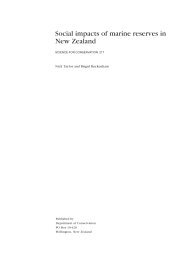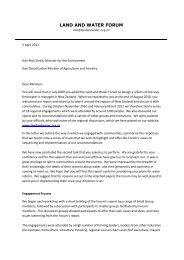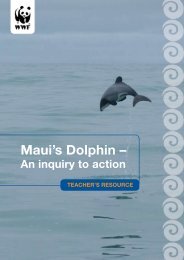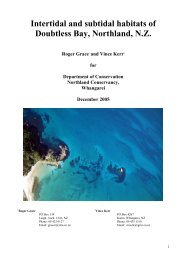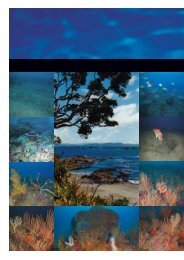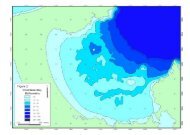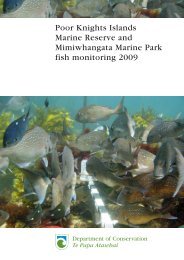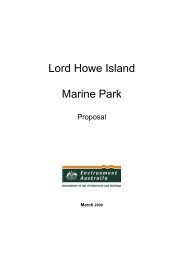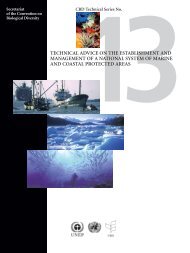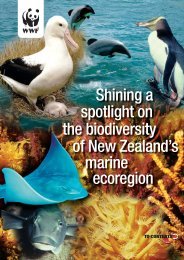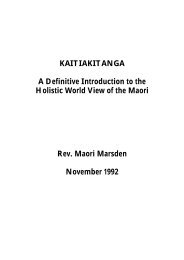Habitats and Ecological Values of the Hokianga ... - MarineNZ.org.nz
Habitats and Ecological Values of the Hokianga ... - MarineNZ.org.nz
Habitats and Ecological Values of the Hokianga ... - MarineNZ.org.nz
Create successful ePaper yourself
Turn your PDF publications into a flip-book with our unique Google optimized e-Paper software.
R.J. DAVIDSON: V. KERR<br />
HABITATS AND ECOLOGICAL VALUES OF HOKIANGA HARBOUR<br />
APPENDIX 1 Estuarine Evaluation (From Davidson <strong>and</strong> M<strong>of</strong>fat, 1990)<br />
Schemes for ranking terrestrial habitats (Spect et. al., 1974; Ratcliffe, 1977; Wright, 1977;<br />
Imboden, 1978; Park <strong>and</strong> Walls, 1978; Ogle, 1982; Myers et. al., 1987), wetl<strong>and</strong>s (M<strong>org</strong>an, 1982;<br />
Angel <strong>and</strong> Hayes, 1983; Pressey, 1985; Davis, 1987) <strong>and</strong> lagoons (Barnes, 1989) have been<br />
developed in response to a growing need for conservation input into environmental management.<br />
These evaluation methods are not directly applicable to estuarine systems, <strong>and</strong> a system for <strong>the</strong><br />
evaluation <strong>of</strong> whole estuaries <strong>and</strong> parts <strong>of</strong> estuaries has not been previously developed for use in<br />
New Zeal<strong>and</strong>. Two methods for <strong>the</strong> assessment <strong>of</strong> estuarine environments are <strong>the</strong>refore proposed in<br />
this section.<br />
The first method evaluates <strong>the</strong> total estuary, while <strong>the</strong> second method deals with specific areas<br />
within <strong>the</strong> estuary. The criteria are based on ei<strong>the</strong>r modified terrestrial criteria or directly on<br />
estuarine values. Information <strong>of</strong> this type, as well as being descriptive, allows estuarine systems to<br />
be assessed on conservation grounds. Evaluation is, <strong>the</strong>refore, an important tool for developing<br />
estuarine management guidelines.<br />
Evaluation <strong>of</strong> an Estuary<br />
Criteria used are:<br />
1. Representativeness/uniqueness <strong>of</strong> <strong>the</strong> estuary, compared with o<strong>the</strong>r estuaries in <strong>the</strong> region.<br />
Representativeness/uniqueness may be classified using flora, fauna, vegetation <strong>and</strong>/or<br />
geological <strong>and</strong> physical data. In <strong>the</strong> Nelson Marlborough area, Waimea Inlet was classified<br />
as unique, principally because <strong>of</strong> <strong>the</strong> diversity <strong>and</strong> rarity <strong>of</strong> <strong>the</strong> flora <strong>and</strong> fauna <strong>and</strong> on <strong>the</strong><br />
physical structure <strong>of</strong> <strong>the</strong> estuary.<br />
2. The state <strong>of</strong> <strong>the</strong> estuary. This is an assessment <strong>of</strong> <strong>the</strong> degree to which <strong>the</strong> estuary has been<br />
physically modified from its pristine through minor or localised modification to major<br />
modification <strong>and</strong> habitat loss.<br />
3. Pollution status <strong>of</strong> an estuary. This may range from no pollution through minor effluent<br />
discharge in localised areas to nutrient enrichment influencing large areas <strong>of</strong> estuary.<br />
4. Degree <strong>of</strong> modification <strong>of</strong> <strong>the</strong> terrestrial surrounding <strong>the</strong> estuary. Intact terrestrial<br />
vegetation scores highly, while farmed, industrial or stop-banked estuarine margins rank<br />
lowly.<br />
5. State <strong>and</strong> degree <strong>of</strong> intact salt marsh vegetation.<br />
6. Size <strong>of</strong> <strong>the</strong> estuary. Large estuaries are rare in New Zeal<strong>and</strong>: only ten are larger than 2000<br />
ha (McLay, 1976). Approximately 68 % <strong>of</strong> estuaries in this country are less than 500 ha in<br />
size.<br />
7. Total number <strong>of</strong> invertebrate species in <strong>the</strong> estuary.<br />
8. Number <strong>of</strong> water bird species present in <strong>the</strong> estuary for all or part <strong>of</strong> <strong>the</strong> year.<br />
9. Number <strong>of</strong> fish species living, visiting or migrating through <strong>the</strong> estuary at some stage <strong>of</strong><br />
<strong>the</strong>ir life history.<br />
10. Maximum density <strong>of</strong> cockles recorded from <strong>the</strong> estuary.<br />
11. Number <strong>of</strong> intertidal vascular plant species present. <strong>Values</strong> above 20 species is considered<br />
high, while less than ten species is regarded as low.<br />
This evaluation, <strong>the</strong>refore, incorporates scientific <strong>and</strong> subjective assessments <strong>and</strong> requires that a full<br />
biological study be undertaken before all criteria can be accurately answered. Small or limited<br />
biological surveys would give lower scores than could be achieved with a large survey <strong>and</strong> can not<br />
<strong>the</strong>refore be used with any confidence.<br />
PAGE 31 3/06/2005 DAVIDSON ENVIRONMENTAL LTD 389/2001





